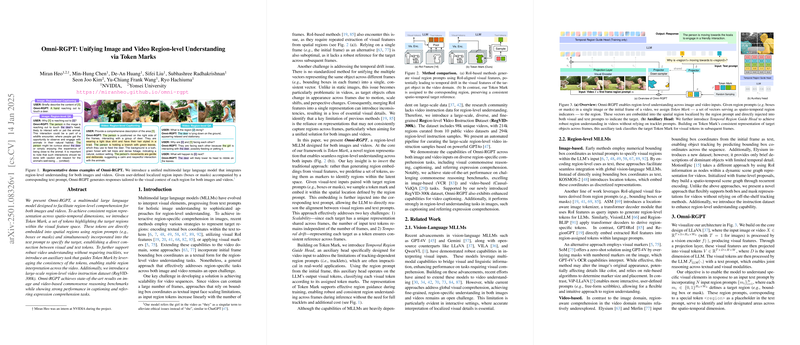An Overview of Omni-RGPT: Unifying Region-Level Understanding in Multimodal Contexts
The paper introduces Omni-RGPT, a multimodal LLM (MLLM) designed to address the challenges of region-level comprehension across both image and video data. The focus of the research is on enhancing the integration of visual and textual data through a mechanism termed Token Mark, which establishes a robust linkage between language and spatio-temporal visual features at the region level.
Omni-RGPT distinguishes itself by employing Token Mark, a novel representation that associates predefined tokens with spatial regions using masks or bounding boxes. These tokens are treated as distinct identifiers, enabling the model to maintain consistent region representation across multiple frames in videos and regions in images. This approach effectively addresses two prevalent challenges in multimodal understanding: scalability in video processing and temporal drift. Scalability is achieved as each region is represented by a unique token mark, avoiding the increase in required input tokens with more frames. Temporal drift is mitigated by ensuring that the same token consistently identifies the target region across different frames.
Furthermore, the authors enhance video comprehension by introducing Temporal Region Guide Head—an auxiliary task specific to video inputs. This task classifies visual tokens in subsequent frames based on their assigned token marks, bypassing the need for object tracking systems that are often computationally intensive and impractical in real-world applications.
The model is evaluated on new datasets developed by the authors, specifically RegVID-300k, a large-scale region-level video instruction dataset containing 98,000 unique videos with 214,000 region annotations. This dataset is pivotal for training models like Omni-RGPT in generating detailed, context-rich video captions and handling complex tasks such as video-based commonsense reasoning.
On several benchmarks, including Causal-VidQA and Visual Commonsense Reasoning (VCR), Omni-RGPT reports superior performance compared to existing approaches. Notably, the model achieves state-of-the-art results in image-based and video-based commonsense reasoning while excelling in tasks such as video captioning and referring expression comprehension.
The implications of this research are significant for the field of artificial intelligence and multimodal learning. By addressing core challenges in integrating visual and textual data across dynamic visual environments, Omni-RGPT lays the groundwork for more complex and nuanced interactions in human-computer interaction. The proposed Token Mark mechanism and subsequent region-head details could be further explored for application in various real-world scenarios, potentially extending to domains such as autonomous driving, robot vision, and interactive AI systems.
Future developments may focus on scaling this architecture to handle longer sequences or integrate with more diverse datasets, enhancing the robustness and applicability of region-level understanding models in broader multimodal contexts.
